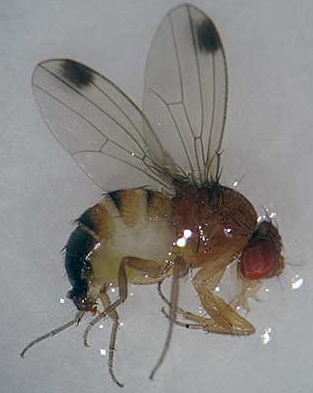
August 18, 2014, Simcoe, Ont – Spotted wing drosophila is now present throughout most of Ontario.
With the exception of northern Ontario (i.e. North Bay, Sudbury and further north), most berry growers should assume this pest is present on their farm. We do not have enough traps to definitely say if SWD is a problem in northern Ontario or not – so growers there should be on the look-out. Do salt tests and check fruit for damage on a regular basis.
Otherwise, we have trapped SWD at most sites across Ontario and numbers are really ramping up. At some sites, where strawberries and cherries have been harvested and there are no other berry crops on the farm, numbers have increased to more than 1,000 per trap. To me, this means that SWD has completed at least one generation at the end of harvest for these fruit crops and is now moving to other susceptible crops.
OMAF have been rearing SWD from fruit collected weekly at some sites. For the first time, we have reared SWD from blueberries (collected July 31) and day neutral strawberries (collected July 28).
Growers have reported signs of SWD damage in their commercial blueberry crops for the first time this season. From our samples, we know that SWD has been present in wild hosts since July 11.
All growers with susceptible fruit should be actively managing SWD, using all of the following strategies:
- Weekly insecticide applications with a registered product. http://www.omafra.gov.on.ca/english/crops/facts/swd-registrations.pdf
- Frequent and thorough harvest of all ripe fruit in the field. This means going over raspberries daily except for days missed due to pesticide application, strawberries every two to three days and blueberries as often as possible.
- Immediate cooling of harvested product.
A few more tips:
- Malathion is an effective product for SWD but residual control drops quickly, especially after rain. Delegate and, for organic growers, Entrust, are excellent options for SWD now that the pressure is high.
- Insecticides for SWD work because they are killing adult flies in the field. The adults are killed when they contact treated fruit and foliage in the field. Do not spray wild hosts or forest edges.
- Producers can use salt tests to check for the presence of larvae in harvested fruit. These tests provide important follow-up information on the effectiveness of management programs.
How to help? Feedback is needed. Please help us assess the economic cost of SWD to business by sharing notes on crop losses and extra expenses to manage SWD.
How can we help? We have been monitoring for SWD since 2011, thanks to funding from the Ontario Berry Growers Association, the Ontario Highbush Blueberry Growers Association and considerable help from OMAF staff and consultants in the field. Funding is nearing its end. What is important for next year? Please send comments to pam.fisher@ontario.ca and/or info@ontarioberries.com
Print this page
